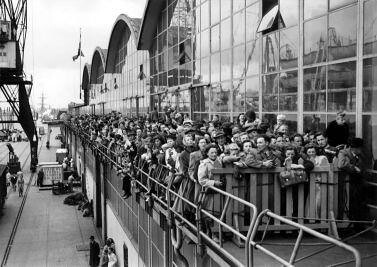The website
Next in our series of online records is the website of het Nationaal Archief, the Dutch National Archive in The Hague.
What do they have?
The website has everything you can expect from a national archive: Practical information about the archive, summaries of their collections, research guides, etc. They also publish several databases, including:
Is there an English interface?
Parts of the website are available in English, German, French and Spanish. The Emigrants to Australia database has an English interface, all other databases we look at today are only available in Dutch. Click English at the top of the page for an English interface (where available).
How do I use it?
That depends on the database.
The easiest way is to enter a surname in the Quick Search field at the top, followed by the Enter key on your keyboard. There is also an advanced search option. When you have a list of search results, click on the name you are interested in. You will need to agree to a disclaimer, stating you will only use the data for historical research.
You can order copies of the original cards, but only if you can prove the person on the card is deceased, or if you have permission from that person.
An example: I searched for Pardoen and found three results, including:
Pardoen, B., born on 01 april 1917, made the journey on ship Skaubryn, arrival in Australia on februari 1952, emigration card in card-tray Brisbane
Curaçao is one of the Netherlands Antilles, once a Dutch colony and still part of the Kingdom of The Netherlands. Click on Raadplegen van database (Consult database). Fill in your search terms in the box on the left, choose your search options on the right (Alle Woorden, all words, Eén Van De Woorden, any word, or Exacte Zin, exact phrase) and click Zoek. An example of what you may find:
Negerin Anna op 23 augustus 1782 door Joseph Obediente jr voor 200 peso, betaald door de neger Mattheeuw de Vries. Met kwitantie in termijnen, waarvan laatste datum 16 september 1785.
Search results are in Dutch. A translation of the example: Negress Anna on 23 August 1782 by Joseph Obediente Jr for 200 pesos, paid by the negro Mattheeuw de Vries, with quittance in instalments, the last on 16 September 1785.
Freed slaves in former Dutch colony Surinam really consists of two databases. First you have to choose between Surinaamse manumissies 1832-1863, the database of slaves that became free between 1832 and 1863, and Emancipatie 1863, slaves that were freed when slavery was abolished by The Netherlands in 1863. Click Raadplegen database on the top of the page. Searching works the same as in the Curaçao database, but you have extra options: You can search for Naam Vrijgelatene (name of the freed slave), Naam Eigenaar (name of the owner), Naam Borgen (name of the sureties), or Aanmerkingen (remarks) for the first database, Slaven en eigenaren (slaves and owners), Slaven (slaves only), Eigenaren (owners only) or Opmerkingen (remarks) for the second.
Fill in a search term, check if you want to search Memotekst (memo text) and Datum (date) fields, choose between Geboorten/dopen (births and baptisms), Lidmaten (church membership lists), Kerkgerechtigheden (church taxes) or (Onder)trouw (marriage and marriage registration), and press Zoek. In the list of search results, click detail.
An example: A baptism on 20 January 1704. The text is in Dutch again.
gedoopt het kint waar van vader was Pieter de Jonge en moeder een indiaaninne genaamt Catharina. Getuijge M: de Jonge d' oude. [transl. baptized the child of which the father was Pieter de Jonge and mother an indian named Catharina. Witness M. de Jonge the elder]
The database of the VOC (Dutch East Indies company) is a large, ongoing project. It lists employees of the VOC sailing to the East. They are taken from the scheepssoldijboeken (ship payrolls), part of the VOC's salary administration. These payrolls are amazingly complete and consistent.
The easiest way to search is to enter a surname in the Snel zoeken (quick search) field at the top, and press the enter key. There is also an advanced search option (Uitgebreid zoeken, in the navigation menu on the left). Fields in the advanced search include Achternaam (surname), Voornaam (first name), Herkomstplaats (place of origin), and Schip (Ship). Fill in the fields and press Zoek.
When you get the list of search results, click on a name for details. On the detail page you will find gegevens (data) about the person you selected, and about his journey. Data include Datum indiensttreding (date of start of employment), Datum uit dienst (date of end of employment), Reden uit dienst (reason for ending the employment, often overleden, deceased), Schip (name of ship), Vertrek (departure), and Aankomst (arrival).
Enter your search phrase in the zoek (search) field on the left and press enter. There is also an advanced search option (Uitgebreid zoeken), with fields like Beschrijving (description), Dag/Maand/Jaar (day/month/year), Periode vanaf/tot en met (year from/to), Trefwoord (keyword), and Fotograaf (photographer).
There is also a single search interface for all databases. Fill in a search phrase (most likely, a surname) at Zoekwoorden (search terms), make sure Alles (everything) is checked, and click Zoek. The result page is in Dutch, search for (and click) Toon resultaten in de thema databases (show search results in the themed databases), next click on a database name, and then click on a search result.
How much does it cost?
Use of the databases is free. There are (often hefty) fees for ordering copies.
You may make prints of the images in the image database for personal use, for any other use there will be charges (source: Auteursrechten). Please contact the national archive for details.
Future plans
Some of the databases are finished projects, others are far from complete. The VOC database, for instance, will probably be complete in 2012 (data entry started in 2000). I expect that new projects will be added from time to time.
Conclusion
The databases featured above are only the tip of the iceberg. The website of the Dutch National Archive hosts many exciting projects and databases. Navigating the website can be a challenge, though. It is a pity that so few databases are available in English.
Labels: Australia, Emigration, Netherlands Antilles, Online genealogy, Suriname, VOC


















0 Comments:
Post a Comment
<< Home